
WEED IT & REAP
Gardening as a ‘Science test'
7/9/2014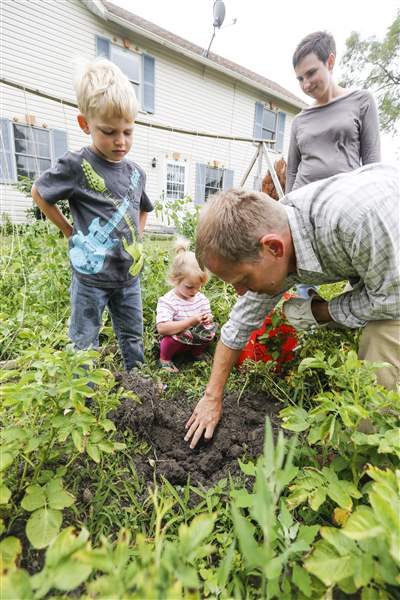
Henri, Audrey, Jason, and Jenn Day dig up their first potatoes of the season.
The Blade/Jetta Fraser
Buy This Image
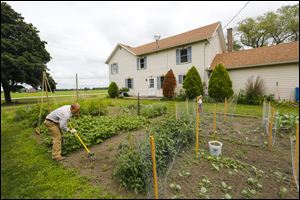
Jason Day, a teacher at St. Johnâs Jesuit Academy, gardens in rural Bowling Green.

Henri, Audrey, Jason, and Jenn Day dig up their first potatoes of the season.
Weed It & Reap is looking for gardeners of all varieties who cultivate the soil in all manners. Briefly tell us what’s unique about you or your garden. Contact Tahree Lane at 419-724-6075 and tlane@theblade.com.
BOWLING GREEN — Jason and Jenn Day moved from Toledo to a 1.3-acre corner lot surrounded on two sides by corn fields, almost two years ago, with their children, Henri, 5 and Audrey, 3. In rural Bowling Green, their old farmhouse dates to the 1880s and came with an old barn.
Jason begins a new bed by covering the area with black plastic sheeting secured by rocks; over time, the grass will die and the matted roots can be easily tilled. He sometimes turns up cinder blocks, rocks, and rubble. He amends the soil with compost, bone meal, and store-bought compost. He waters by hand from rain barrels next to the barn and the house.
PHOTO GALLERY: Jason and Jenn Day
He’s among that subset of gardeners curious about the science of seed, soil, and weather, who look for better yields, varieties, and ways to extend the growing season, improve soil, and manage pests without chemicals. He’s giving companion-planting a try -- interspersing different plants to achieve pest control, pollination, and best use of space: potatoes are interspersed with bush peas and broccoli; basil is planted near tomatoes. “I think it would be neat to test some of those claims,” he said.
For a second crop that will mature this fall, he’s started scores of tiny seedlings in flats near the house. “I’ve planted a lot and want to plant more and more to give to friends and charity kitchens.”
Jason served six years in the Navy, operating nuclear reactors on a submarine. As teacher at St. John’s, he oversees the 40-by-80-foot hoop house, showing middle schoolers how to extend the growing season by starting seeds in spring that are later moved to raised beds outside, and planting winter crops such as spinach, carrots, and onions.
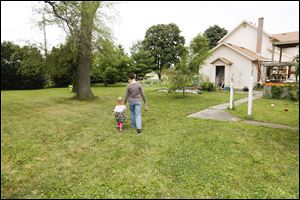
Audrey and her mom, Jenn Day.
His book recommendations include The Winter Harvest Handbook and The New Organic Gardener by Elliot Coleman; The Seed-Starter’s Handbook by Nancy Bubel, and The Classic Italian Cookbook by Marcella Hazan, particularly her tomato sauce recipe which can also be found online.
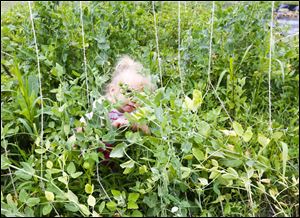
Audrey Day gets lost among the snap peas.
Garden dimensions: Main plot is 25-by-50-feet, four others are about 16-by-20-feet. There are a couple of small berry patches. All plots are expanding.
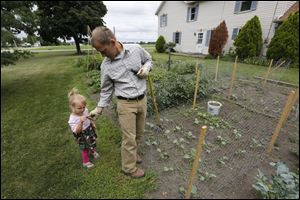
Audrey and her dad share a snap pea.
When did you start gardening? As a boy, I gardened with my grandfather in Monclova Township. My mother worked, so we spent a lot of time during the summers there. We’d get in the middle of the raspberry patch and just eat them. My grandmother did a lot of canning and pickling.
At our first home in Toledo in 2005, I started with square-foot gardening in two raised beds with tomatoes, peppers, onions, rosemary, basil, and sage from Seed Savers Exchange [a nonprofit dedicated to saving and sharing heirloom seeds].
What do you grow? For tomatoes, I always grow the the meaty, flavorful Cherokee purple, which you have to pick when it has just a little bit of red color, and Martino’s roma, which has the best flavor for pasta sauces. And I always try some different tomatoes; this year it’s Minibel, a foot-high bushy plant covered with little tomatoes for the kids, and grape d’inverno because I’m looking for a nice little grape tomato, which we prefer over cherry tomatoes.
Potatoes (especially yellow finn with its buttery, sweet flavor, yukon gold, and German butterball). Red and orange bell peppers, onions, leeks, shallots, spinach, beans, asparagus (from seed), broccoli, cauliflower, eggplant, carrots, corn, and tomatillos. I’d like to have enough peas to save but the kids eat them in the garden. Among herbs we’ve got sage, rosemary, thyme, cilantro, parsley, oregano, summer savory, and epazote -- a leafy herb with flavor described as having traces of oregano, mint, savory, citrus; I’ve made a corn/zucchini soup with it. Also, strawberries (old North Sea variety), blueberries, and raspberries. Along the road in front we plan to plant native flowers and grasses.
Favorite plant: Rosemary. It has such a good aroma and goes great with a roasted chicken recipe and a pasta sauce.
Give us a tip: Build your garden as a beautiful place, to be a part of the landscaping. You‘ll enjoy it more and maybe will encourage other neighbors to quit mowing grass and start growing beautiful vegetables, fruits, and native flowers.
Hours spent gardening per week: About 27-30.
Annual expense: $300 for seeds, amendments, starting medium, compost.
Challenges: Weeds. And rabbits have eaten my first three plantings this year of broccoli and cauliflower; the fourth planting is inside a fenced area. I’m trying green manures to improve the soil, and have planted crimson clover and red clover seeds between the vegetable rows to suppress weeds and keep the soil covered. Clover is a legume that fixes nitrogen in the soil, and at the end of the season, you turn it under.
I’m proud of: Bringing in the food I tend to the dinner table and watching my children enjoy fresh fruit and vegetables right out of the garden with the dirt on it still! (We are working on that with our 3-year-old.)
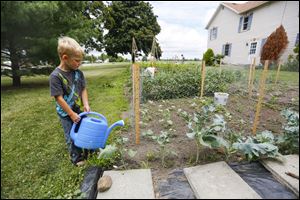
Henri Day waters broccoli, his favorite
What do you get out of gardening? I get a sense of reward for noble work performed in tending to the living things in my garden. I have deeper sense of my connection with the cycles of life and the seasons. And I feel that I’m giving value to something truly valuable: the source of our food. Finally, I get a wonderful rush of wonder when I am out in the nature of my garden.
Contact Tahree Lane at: tlane@theblade.com or 419-724-6075.